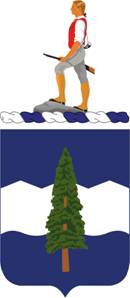383rd (Infantry) Regiment, US Army: Difference between revisions
Knorrepoes (talk | contribs) m (Text replacement - "{{us}}" to "") |
Knorrepoes (talk | contribs) m (Text replacement - "The Coat of Arms was " to "The arms were ") |
||
| Line 15: | Line 15: | ||
The blue shield is representative of Infantry. The white saw-tooth fess alludes to the mountains of Washington and the lower wavy line of the fess indicates the waters of the Pacific. The pine tree is emblematic of western Washington, the home area of the original unit in 1922. | The blue shield is representative of Infantry. The white saw-tooth fess alludes to the mountains of Washington and the lower wavy line of the fess indicates the waters of the Pacific. The pine tree is emblematic of western Washington, the home area of the original unit in 1922. | ||
The | The arms were originally approved for the 383d Infantry Regiment on 25 October 1925. It was amended to withdraw the Army Reserve crest on 24 September 1959. It was amended to reinstate the crest of the Army Reserve and revise the symbolism of the design on 7 August 1970. The insignia was redesignated for the 383d Regiment with blazon and symbolism revised on 28 October 1993. The Distinctive Unit Insignia was originally approved for the 383d Infantry Regiment on 5 August 1954. It was amended to revise the symbolism of the design on 7 August 1970. It was redesignated for the 383d Regiment with description and symbolism revised on 28 October 1993. | ||
Revision as of 05:30, 28 December 2022
383RD (INFANTRY) REGIMENT, US ARMY
Official blazon
Shield: Azure, a fess dancetty to chief and wavy to base Argent, overall a pine tree Proper.
Crest: That for the regimens and separate battalions of the Army Reserve: From a wreath Argent and Azure, the Lexington Minute Man Proper. The statue of the Minute Man, Captain John Parker (H.H. Kitson, sculptor), stands on the Common in Lexington, Massachusetts.
Motto: DEPENDABLE.
Distinctive Unit Insignia. Description: A Silver color metal and enamel device 1 1/8 inches (2.86 cm) in height overall, consisting of a shield blazoned: Azure, a fess dancetty to chief and wavy to base Argent, overall a pine tree Proper. Attached below the shield, a Blue scroll doubled back and inscribed “DEPENDABLE” in Silver.
Origin/meaning
The blue shield is representative of Infantry. The white saw-tooth fess alludes to the mountains of Washington and the lower wavy line of the fess indicates the waters of the Pacific. The pine tree is emblematic of western Washington, the home area of the original unit in 1922.
The arms were originally approved for the 383d Infantry Regiment on 25 October 1925. It was amended to withdraw the Army Reserve crest on 24 September 1959. It was amended to reinstate the crest of the Army Reserve and revise the symbolism of the design on 7 August 1970. The insignia was redesignated for the 383d Regiment with blazon and symbolism revised on 28 October 1993. The Distinctive Unit Insignia was originally approved for the 383d Infantry Regiment on 5 August 1954. It was amended to revise the symbolism of the design on 7 August 1970. It was redesignated for the 383d Regiment with description and symbolism revised on 28 October 1993.
Literature: Image from Wikimedia Commons
. Information from The Institute of Heraldry, US Army.
